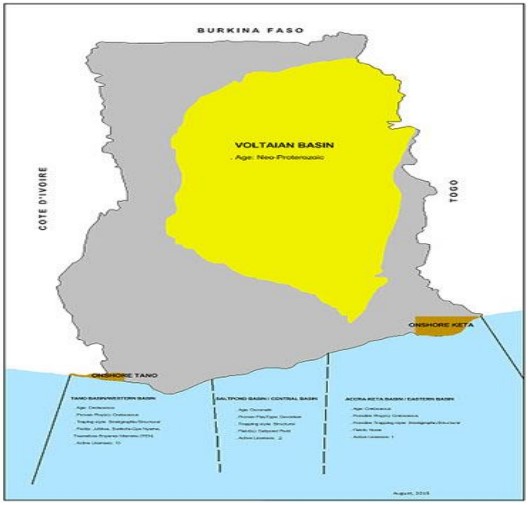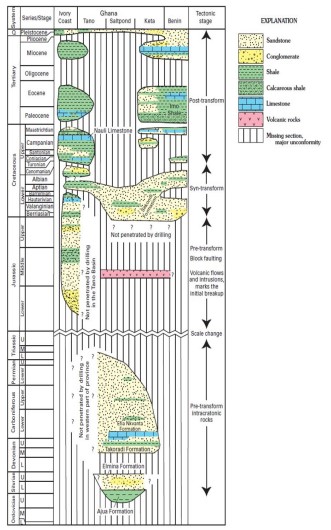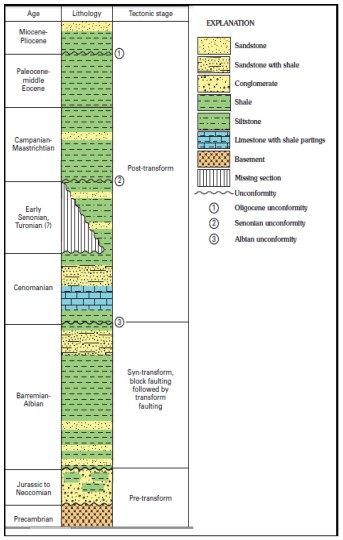
Тип бассейна: Платформ
Подтип бассейна: Пассивных окраин (перикратонно-океанический)
Класс бассейна: Периокеанический
Возраст бассейна: Зрелый - Мезозойский
Тип полезных ископаемых:
Геологический возраст начало:
Геологический возраст конец:
Площадь: 86466.59 км²
Sedimentary basins in Ghana
Ghana has four sedimentary basins namely Tano, Saltpond, Keta and Voltaian Basins (Figure 1). The Tano, Keta, Saltpond are located along the coastal shores of Ghana which resulted from the continental rifting during the Early Cretaceous epoch. The Voltaian basin is an inland basin which is of Paleozoic age like the Saltpond basin. The Tano and Keta Basins are of Cretaceous ages. These basins make up nearly onehalf of Ghana’s total area and exploration of oil and natural gas is mainly focused on these areas. The Tano basin covers an area of 1165 sq. km, Keta basin is 2200 sq. km, Volta Basin is 103,600 s.q. km and that of the Continental shelf is of 27560 sq. km (Arku, 2012).

Figure 1. Sedimentary basins in Ghana (Petroleum Commission, 2019).
Due to continuous continental rifting about 125 Ma between Africa and South America leading to subsidence and sagging resulting in the formation of deep basins along the edges of the transform belt. This permitted the deposition and preservation of organic matter under anoxic conditions forming thick organic rich shale source rocks which was deposited during the Albian, Cenomanian and Turonian period (Brownfield and Charpentier, 2006; Adda, 2013; CGG, 2016). Figure 4.5 shows some of the basins in Ghana along the Gulf of Guinea.

Figure 2. Stratigraphic section of the Basins in Ghana along the Gulf of Guinea (Brownfield, 2016)
Tano basin
The Tano basin is a deep infilled sedimentary basin found on the West African Transform Margin which seems to be like a wrench, pull-apart like with faults and anticlines and pinch out as the main trap system (Tetteh, 2016). The Basin is situated in the southwestern part of Ghana with a little portion of it inland and most of it offshore (Tetteh, 2016) and an extension of the Ghana-Ivory Coast Basin (Ablordeppey, 2016). The Tano basin is one of the sedimentary basins formed during the Late Jurassic period when the Atlantic rifting system began to break up the Paleocontinents of Africa and Southern America (CGG, 2013) and the separation of the of the African and South American plate during the Albian period (Ablordeppey, 2016). Large turbidite fan or channel complexes of thick clastic sequence in the basin from fluvial and lacustrine environments resulting from several lakes and river systems have played significant roles in the deposition of these clastic sequence in the early Cretaceous epoch (Adda, 2013). After the deposition of these clastic sequence within the basin, it resulted in three main play systems mainly Albian, Cenomanian and Turonian play. Figure 3 shows the cross section of offshore Tano basin.

Figure 3. Cross section of offshore Tano basin showing the play types present (IHS Report, 2011 as cited by Tetteh, 2016).
The largest discoveries and productive fields are within the Turonian play and known as the Jubilee and TEN fields. Other substantial discoveries have also been made in the Cenomanian play like the Sankofa field (Tetteh, 2016). The main tectonic processes that influenced the formation of the Tano Basin during the rifting period are the Pre-rift phase during the Precambrian and late Jurassic, Syn-rift phase accompanied by sediments of early Cretaceous age and a Post-rift phase of marine Cenomanian up to date (Nana Gyamfua, 2015).
The Tano basin has been stratigraphically divided from the base to the upper section (Figures 4.5,4.6 and 4.7) (Atta-Peters, 2013; Amoo Micheal, 2014; Tetteh, 2016). The Basin is about 7000 to 9000 feet deep with the basement rock of early Aptian age followed by the Bonyere shale formation which was deposited at the same time which is the source rock and the sandstones are which were deposited after serves as the reservoir rock. The presence of an unconformity in the basin is as a result of an uplift and erosional event during the Upper Albian age (Tetteh, 2016).
Aptian Series: The Aptian series is made up of the lower Aptian (Kwabenaswaso formation) and the upper Aptian. The lower Aptian sequence is observed in the north and south of the basin. It unconformably overlies the Carboniferous consisting of finegrained sandstones with poor porosity formed in interbedded sandstones and characterized as well by dark shales (Davis, 1986 as cited by Ablordeppey, 2016). The upper Aptian sequence is made of thick shale interbedded with sandstone and siltstones.

Figure 4. Stratigraphy of the Tano Cape Three Points Basin of Ghana (Doku, 2015)
Cenomanian Formation: The Cenomanian formation is made of mainly shale. It was deposited after the sandstones with huge deposits of limestones within the Cenomanian age (Tetteh, 2016). In the deeper area above the Cenomanian is the presence of an unconformity. From the bottom of the Cenomanian to the upper sequence are embedded sandstone and limestone overlie by a thin sequence of black shale. In the Cenomanian are limestone that overlies shoal limestone which are both late Cretaceous in age. The lower middle Cenomanian in the shallow area is defined by an embedded fine to coarse grained sand with sporadic calcite cement and grey, variably silty mudstone (RRI, 1998; Davis, 1986 and RRI 1998 as cited by Ablordeppey, 2016).
Turonian and Upper Santonian, Campanian and Maastrichtian: At about 920 feet, the presence of the Turonian and Upper Santonian portion is observed. It is made up of grey shales and claystones, occasionally having characteristics of dolomite or limestones (Tetteh, 2016).
Turonian: Claystones with thinly embedded siltstone and limestone can be observed in the Turonian (Ablordeppey, 2016). Features of dark grey, angular, calcareous and silty are imprints in the claystones and the siltstones have calcareous cement like features (Davies 1998 as cited by Ablordeppey, 2016). It is this portion which has the commercial accumulations of the Tano offshore plays (eg. Jubilee Field, Tweneboa Field) (Nana Gyamfua, 2015).
Santonian: Between the Turonian and the Campanian is the Santonian formation with a thickness of 412 meters with the sediments mostly dark grey shales with interbedded siltstones. The base of the formation is mostly dominated by unconsolidated sands. A marine deposition environment can be observed in the sequence during deposition (Davies, 1986 as cited by Ablordeppey, 2016).
Campanian: The Campanian section follows the Turonian and Upper Santonian which is composed of portion of shale rich with occasional stringers of dolomite and limestone where the Teak and Odum fields were discovered (Gyamfua, 2015; Tetteh, 2016).
Maastrichtian: The Maastrichtian portion indicates the later stages of the Upper Cretaceous dominated by claystone as well as sandstone and dolomite with a thickness of between 138 to 178 meters observed in the Tano. (Gyamfua, 2015; Tetteh, 2016). Davies, 1986 as cited in Ablordeppey, 2016 states that, the two sections (upper and lower) of the Maastrichtian is mainly made up of unconsolidated coarse-grained sandstones interbedded with fossiliferous and glauconitic mudstones.
Tertiary: The Tertiary section is mainly composed of the Paleocene, Eocene, Oligocene and Miocene ages (Gyamfua, 2015). Unconformity is observed in the Cretaceous due to the absence of the Lower Paleocene where the Poleocene overlies in the Tano basin (Ghana National Petroleum Cooperation, 1998 as cited by Ablordeppey, 2016). The middle and lower sections of the Eocene consist of finely laminated dark grey/ brown claystones with thin beds of fossiliferous dolomite and fine sandstone. The events of uplifting and erosion during the Alpine Orogeny caused huge deposition of thin bedded or completely absence of the the Paleocene, Upper Eocene and Oligocene portions. (Gyamfua, 2015; Tetteh, 2016).
Source Rock: The Tano basin is mainly composed of shale source rocks from the Upper Albian, Cenomanian and Turonian ages. These source rocks are interbedded with the reservoir rocks that are intimately connected (Tetteh, 2016). The Kerogen types with the Tano are type II and Type III with some source rock plays indicating type I and type IV. The Total Organic Content potential (TOC) ranges from 1-4 proving the source rocks are of good to very good TOC values. This has lead to huge hydrocarbon yield in the Tano Basin (Tetteh, 2016).
Reservoir: Large turbidite channel complexes in the deeper parts of the Tano basin were formed due to the deposition of clastic sediments from the Tano river drainage system from the western parts of Ghana and Ivory Coast (Adda, 2013). The plays of the reservoir system in the Tano basin are the Albian reservoir play, Maastrichtian sandstones, Cenomanian Series, Turonian Series, and Campanian sandstones. Among these plays, the most successful and important due to the accumulation of hydrocarbon in commercial quantities is the Turonian series play. The Jubilee field, Tweneboa, Enyera and Ntome (TEN) fields are indicators of huge discoveries of the basin (Adda, 2013; Ablordeppey, 2016). The reservoir plays have porosity values ranging from 17- 23% with permeability of 100-3000 Md. The net gross ratio ranges from 30-80% and oil saturation also ranges from 60-90%. The API of the oil in the Turonian series is 32- 38o. Tetteh (2016) also states that the Albian sandstone reservoir made only one oil and gas discovery. The accumulation of hydrocarbons within the Cenomanian sandstone reservoir has not been very productive and only one discovery has been made in this play.
Seals and Traps: The seals in the basin are marine shales composed of Turonian Shale series, Albian Shale series and Cenomanian Shale series (Tetteh, 2016). The Trapping system are both stratigraphic and structural traps (Adda, 2013). Structural and stratigraphic trap features such as normal faults, pinch out, clastic depos lens and anticlines exist in the Turonian play series.
The main trapping system in the Albian play is structural with anticlinal features as well as dome like structures and fault blocks. Both structural and stratigraphic traps exist in the Cenomanian play series. These were formed by normal faulting, Pinch outs, draping structure and clastic depos lens. (Tetteh, 2016).
Source: THE PETROLEUM AND NATURAL GAS POTENTIAL OF GHANA. Salamatu Bannib LAMBON, 2020
Следующий Бассейн: Pre-Rif/Rharb/Gharb